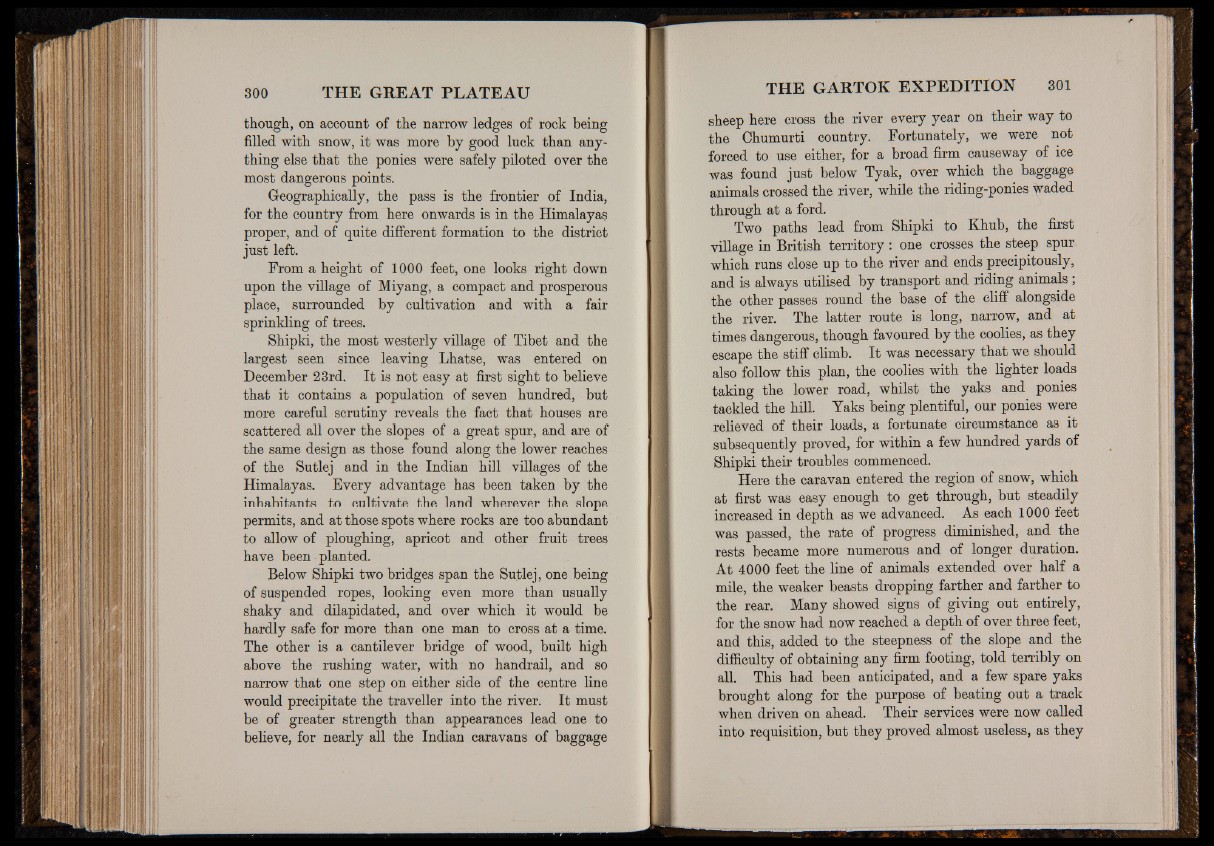
though, on account of the narrow ledges of rock being
filled with snow, it was more by good luck than anything
else that the ponies were safely piloted over the
most dangerous points.
Geographically, the pass is the frontier of India,
for the country from here onwards is in the Himalayas
proper, and of quite different formation to the district
just left.
From a height of 1000 feet, one looks right down
upon the village of Miyang, a compact and prosperous
place, surrounded by cultivation and with a fair
sprinkling of trees.
Shipki, the most westerly village of Tibet and the
largest seen since leaving Lhatse, was entered on
December 23rd. It is not easy at first sight to believe
that it contains a population of seven hundred, but
more careful scrutiny reveals the fact that houses are
scattered all over the slopes of a great spur, and are of
the same design as those found along the lower reaches
of the Sutlej and in the Indian hill villages of the
Himalayas. Every advantage has been taken by the
inhabitants to cultivate the land wherever the slope
permits, and at those spots where rocks are too abundant
to allow of ploughing, apricot and other fruit trees
have been planted.
Below Shipki two bridges span the Sutlej, one being
of suspended ropes, looking even more than usually
shaky and dilapidated, and over which it would be
hardly safe for more than one man to cross at a time.
The other is a cantilever bridge of wood, built high
above the rushing water, with no handrail, and so
narrow that one step on either side of the centre line
would precipitate the traveller into the river. It must
be of greater strength than appearances lead one to
believe, for nearly all the Indian caravans of baggage
sheep here cross the river every year on their way to
the Chumurti country. Fortunately, we were not
forced to use either, for a broad firm causeway of ice
was found just below Tyak, over which the baggage
animals crossed the river, while the riding-ponies waded
through at a ford.
Two paths lead from Shipki to Khub, the first
village in British territory : one crosses the steep spur
which runs close up to the river and ends precipitously,
and is always utilised by transport and riding animals ;
the other passes round the base of the cliff alongside
the river. The latter route is long, narrow, and at
times dangerous, though favoured by the coolies, as they
escape the stiff climb. It was necessary that we should
also follow this plan, the coolies with the lighter loads
taking the lower road, whilst the yaks and ponies
tackled the hill. Yaks being plentiful, our ponies were
relieved of their loads, a fortunate circumstance as it
subsequently proved, for within a few hundred yards of
Shipki their troubles commenced.
Here the caravan entered the region of snow, which
at first was easy enough to get through, but steadily
increased in depth as we advanced. As each 1000 feet
was passed, the rate of progress diminished, and the
rests became more numerous and of longer duration.
At 4000 feet the line of animals extended over half a
mile, the weaker beasts dropping farther and farther to
the rear. Many showed signs of giving out entirely,
for the snow had now reached a depth of over three feet,
and this, added to the steepness of the slope and the
difficulty of obtaining any firm footing, told terribly on
all. This had been anticipated, and a few spare yaks
brought along for the purpose of beating out a track
when driven on ahead. Their services were now called
into requisition, but they proved almost useless, as they